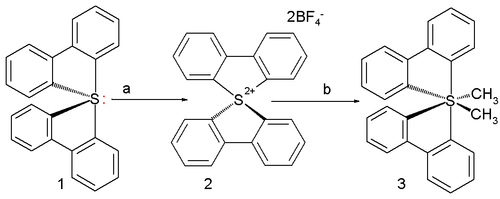Organosulfur compounds
Organosulfur compounds are organic compounds that contain sulfur.[1] They are often associated with foul odors, but many of the sweetest compounds known are organosulfur derivatives, e.g., saccharin. Nature abounds with organosulfur compounds—sulfur is essential for life. Of the 20 common amino acids, two (cysteine and methionine) are organosulfur compounds, and the antibiotics penicillin and sulfa drugs both contain sulfur. While sulfur-containing antibiotics save many lives, sulfur mustard is a deadly chemical warfare agent. Fossil fuels, coal, petroleum, and natural gas, which are derived from ancient organisms, necessarily contain organosulfur compounds, the removal of which is a major focus of oil refineries.
Sulfur shares the chalcogen group with oxygen, selenium, and tellurium, and it is expected that organosulfur compounds have similarities with carbon–oxygen, carbon–selenium, and carbon–tellurium compounds.
A classical chemical test for the detection of sulfur compounds is the Carius halogen method.
Classes
Organosulfur compounds can be classified according to the sulfur-containing functional groups, which are listed (approximately) in decreasing order of their occurrence.
- Illustrative organosulfur compounds
 Allicin, the active flavor compound in crushed garlic
Allicin, the active flavor compound in crushed garlic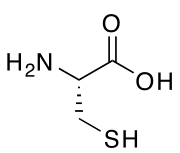 (R)-Cysteine, an amino acid containing a thiol group
(R)-Cysteine, an amino acid containing a thiol group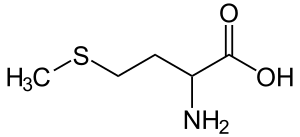 Methionine, an amino acid containing a sulfide
Methionine, an amino acid containing a sulfide Diphenyl disulfide, a representative disulfide
Diphenyl disulfide, a representative disulfide Dibenzothiophene, a component of crude oil
Dibenzothiophene, a component of crude oil Perfluorooctanesulfonic acid, a controversial surfactant
Perfluorooctanesulfonic acid, a controversial surfactant Lipoic acid, an essential cofactor of four mitochondrial enzyme complexes.
Lipoic acid, an essential cofactor of four mitochondrial enzyme complexes.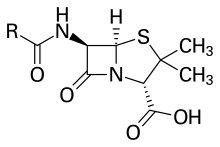 Penicillin core structure, where "R" is the variable group.
Penicillin core structure, where "R" is the variable group. Sulfanilamide, a sulfonamide antibacterial, called a sulfa drug.
Sulfanilamide, a sulfonamide antibacterial, called a sulfa drug. Sulfur mustard, a type of sulfide used as a chemical warfare agent.
Sulfur mustard, a type of sulfide used as a chemical warfare agent.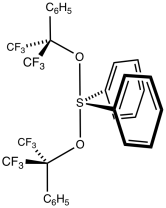 Martin's sulfurane with a see-saw structure, like that of SF4[2]
Martin's sulfurane with a see-saw structure, like that of SF4[2]
Sulfides
Sulfides, formerly known as thioethers, are characterized by C−S−C bonds[3][4] Relative to C−C bonds, C−S bonds are both longer, because sulfur atoms are larger than carbon atoms, and about 10% weaker. Representative bond lengths in sulfur compounds are 183 pm for the S−C single bond in methanethiol and 173 pm in thiophene. The C−S bond dissociation energy for thiomethane is 89 kcal/mol (370 kJ/mol) compared to methane's 100 kcal/mol (420 kJ/mol) and when hydrogen is replaced by a methyl group the energy decreases to 73 kcal/mol (305 kJ/mol).[5] The single carbon to oxygen bond is shorter than that of the C−C bond. The bond dissociation energies for dimethyl sulfide and dimethyl ether are respectively 73 and 77 kcal/mol (305 and 322 kJ/mol).
Sulfides are typically prepared by alkylation of thiols. They can also be prepared via the Pummerer rearrangement. In one named reaction called the Ferrario reaction phenyl ether is converted to phenoxathiin by action of elemental sulfur and aluminium chloride.[6]
Thioacetals and thioketals feature C−S−C−S−C bond sequence. They represent a subclass of sulfides. The thioacetals are useful in "umpolung" of carbonyl groups. Thioacetals and thioketals can also be used to protect a carbonyl group in organic syntheses.
The above classes of sulfur compounds also exist in saturated and unsaturated heterocyclic structures, often in combination with other heteroatoms, as illustrated by thiiranes, thiirenes, thietanes, thietes, dithietanes, thiolanes, thianes, dithianes, thiepanes, thiepines, thiazoles, isothiazoles, and thiophenes, among others. The latter three compounds represent a special class of sulfur-containing heterocycles that are aromatic. The resonance stabilization of thiophene is 29 kcal/mol (121 kJ/mol) compared to 20 kcal/mol (84 kJ/mol) for the oxygen analogue furan. The reason for this difference is the higher electronegativity for oxygen drawing away electrons to itself at the expense of the aromatic ring current. Yet as an aromatic substituent the thio group is less electron-releasing than the alkoxy group. Dibenzothiophenes (see drawing), tricyclic heterocycles consisting of two benzene rings fused to a central thiophene ring, occurs widely in heavier fractions of petroleum.
Thiols, disulfides, polysulfides
Thiol group contain the functionality R−SH. Thiols are structurally similar to the alcohol group, but these functionalities are very different in their chemical properties. Thiols are more nucleophilic, more acidic, and more readily oxidized. This acidity can differ by 5 pKa units.[7]
The difference in electronegativity between sulfur (2.58) and hydrogen (2.20) is small and therefore hydrogen bonding in thiols is not prominent. Aliphatic thiols form monolayers on gold, which are topical in nanotechnology.
Certain aromatic thiols can be accessed through a Herz reaction.
Disulfides R−S−S−R with a covalent sulfur to sulfur bond are important for crosslinking: in biochemistry for the folding and stability of some proteins and in polymer chemistry for the crosslinking of rubber.
Longer sulfur chains are also known, such as in the natural product varacin which contains an unusual pentathiepin ring (5-sulfur chain cyclised onto a benzene ring).
Thioesters
Thioesters have general structure R−C(O)−S−R. They are related to regular esters (R−C(O)−O−R) but are more susceptible to hydrolysis and related reactions. Thioesters are prominent in biochemistry, especially in fatty acid synthesis.
Sulfoxides, sulfones and thiosulfinates
A sulfoxide, R−S(O)−R, is the S-oxide of a sulfide ("sulfide oxide"), a sulfone, R−S(O)2−R, is the S,S-dioxide of a sulfide, a thiosulfinate, R−S(O)−S−R, is the S-oxide of a disulfide, and a thiosulfonate, R−S(O)2−S−R, is the S,S-dioxide of a disulfide. All of these compounds are well known with extensive chemistry, e.g., dimethyl sulfoxide, dimethyl sulfone, and allicin (see drawing).
Sulfimides, sulfoximides, sulfonediimines
Sulfimides (also called a sulfilimines) are sulfur–nitrogen compounds of structure R2S=NR′, the nitrogen analog of sulfoxides. They are of interest in part due to their pharmacological properties. When two different R groups are attached to sulfur, sulfimides are chiral. Sulfimides form stable α-carbanions.[8]
Sulfoximides (also called sulfoximines) are tetracoordinate sulfur–nitrogen compounds, isoelectronic with sulfones, in which one oxygen atom of the sulfone is replaced by a substituted nitrogen atom, e.g., R2S(O)=NR′. When two different R groups are attached to sulfur, sulfoximides are chiral. Much of the interest in this class of compounds is derived from the discovery that methionine sulfoximide (methionine sulfoximine) is an inhibitor of glutamine synthetase.[9]
Sulfonediimines (also called sulfodiimines, sulfodiimides or sulfonediimides) are tetracoordinate sulfur–nitrogen compounds, isoelectronic with sulfones, in which both oxygen atoms of the sulfone are replaced by a substituted nitrogen atom, e.g., R2S(=NR′)2. They are of interest because of their biological activity and as building blocks for heterocycle synthesis.[10]
S-Nitrosothiols
S-Nitrosothiols, also known as thionitrites, are compounds containing a nitroso group attached to the sulfur atom of a thiol, e.g. R−S−N=O. They have received considerable attention in biochemistry because they serve as donors of the nitrosonium ion, NO+, and nitric oxide, NO, which may serve as signaling molecules in living systems, especially related to vasodilation.[11]
Sulfur halides
A wide range of organosulfur compounds are known which contain one or more halogen atom ("X" in the chemical formulas that follow) bonded to a single sulfur atom, e.g.: sulfenyl halides, RSX; sulfinyl halides, RS(O)X; sulfonyl halides, RSO2X; alkyl and arylsulfur trichlorides, RSCl3 and trifluorides, RSF3;[12] and alkyl and arylsulfur pentafluorides, RSF5.[13] Less well known are dialkylsulfur tetrahalides, mainly represented by the tetrafluorides, e.g., R2SF4.[14]
Thioketones, thioaldehydes, and related compounds
Compounds with double bonds between carbon and sulfur are relatively uncommon, but include the important compounds carbon disulfide, carbonyl sulfide, and thiophosgene. Thioketones (RC(=S)R′) are uncommon with alkyl substituents, but one example is thiobenzophenone. Thioaldehydes are rarer still, reflecting their lack of steric protection ("thioformaldehyde" exists as a cyclic trimer). Thioamides, with the formula R1C(=S)N(R2)R3 are more common. They are typically prepared by the reaction of amides with Lawesson's reagent. Isothiocyanates, with formula R−N=C=S, are found naturally. Vegetable foods with characteristic flavors due to isothiocyanates include wasabi, horseradish, mustard, radish, Brussels sprouts, watercress, nasturtiums, and capers.
S-Oxides and S,S-dioxides of thiocarbonyl compounds
The S-oxides of thiocarbonyl compounds are known as thiocarbonyl S-oxides or sulfines, R2C=S=O, and thiocarbonyl S,S-dioxides or sulfenes, R2C=SO2. These compounds are well known with extensive chemistry, e.g., see syn-propanethial-S-oxide and sulfene.
Triple bonds between carbon and sulfur
Triple bonds between sulfur and carbon in sulfaalkynes are rare and can be found in carbon monosulfide (CS) [15] and have been suggested for the compounds F3CCSF3 [16][17] and F5SCSF3.[18] The compound HCSOH is also represented as having a formal triple bond.[19]
Thiocarboxylic acids and thioamides
Thiocarboxylic acids (RC(O)SH) and dithiocarboxylic acids (RC(S)SH) are well known. They are structurally similar to carboxylic acids but more acidic. Thioamides are analogous to amides.
Sulfonic, sulfinic and sulfenic acids, esters, amides, and related compounds
Sulfonic acids have functionality R−S(=O)2−OH.[20] They are strong acids that are typically soluble in organic solvents. Sulfonic acids like trifluoromethanesulfonic acid is a frequently used reagent in organic chemistry. Sulfinic acids have functionality R−S(O)−OH while sulfenic acids have functionality R−S−OH. In the series sulfonic—sulfinic—sulfenic acids, both the acid strength and stability diminish in that order.[21][22] Sulfonamides, sulfinamides and sulfenamides, with formulas R−SO2NR′2, R−S(O)NR′2, and R−SNR′2, respectively, each have a rich chemistry. For example, sulfa drugs are sulfonamides derived from aromatic sulfonation. Chiral sulfinamides are used in asymmetric synthesis, while sulfenamides are used extensively in the vulcanization process to assist cross-linking. Thiocyanates, R−S−CN, are related to sulfenyl halides and esters in terms of reactivity.
Sulfonium, oxosulfonium and related salts
A sulfonium ion is a positively charged ion featuring three organic substituents attached to sulfur, with the formula [R3S]+. Together with their negatively charged counterpart, the anion, the compounds are called sulfonium salts. An oxosulfonium ion is a positively charged ion featuring three organic substituents and an oxygen attached to sulfur, with the formula [R3S=O]+. Together with their negatively charged counterpart, the anion, the compounds are called oxosulfonium salts. Related species include alkoxysulfonium and chlorosulfonium ions, [R2SOR]+ and [R2SCl]+, respectively.
Sulfonium, oxosulfonium and thiocarbonyl ylides
Deprotonation of sulfonium and oxosulfonium salts affords ylides, of structure R2S+−C−−R′2 and R2S(O)+−C−−R′2. While sulfonium ylides, for instance in the Johnson–Corey–Chaykovsky reaction used to synthesize oxiranes, are sometimes drawn with a C=S double bond, e.g., R2S=CR′2, the ylidic carbon–sulfur bond is highly polarized and is better described as being ionic. Sulfonium ylides are key intermediates in the synthetically useful Stevens rearrangement. Thiocarbonyl ylides (RR′C=S+−C−−RR′) can form by ring-opening of thiiranes, photocyclization of aryl vinyl sulfides,[23] as well as by other processes.
Sulfuranes and persulfuranes
Sulfuranes are relatively specialized functional group that are tetravalent, hypervalent sulfur compounds, with the formula SR4[24] and likewise persulfuranes are hexavalent SR6. All-carbon hexavalent complexes have been known for the heavier representatives of the chalcogen group, for instance the compound hexamethylpertellurane (Te(Me)6) was discovered in 1990[25] by reaction of tetramethyltellurium with xenon difluoride to TeF2(CH3)4 followed by reaction with dimethylzinc. The sulfur analogue hexamethylpersulfurane (S(CH3)6) has been predicted to be stable[26] but has not been synthesized yet.
The first ever all-carbon persulfurane actually synthesized in a laboratory has two methyl and two biphenyl ligands:[27]
It is prepared from the corresponding sulfurane 1 with xenon difluoride / boron trifluoride in acetonitrile to the sulfuranyl dication 2 followed by reaction with methyllithium in tetrahydrofuran to (a stable) persulfurane 3 as the cis isomer. X-ray diffraction shows C−S bond lengths ranging between 189 and 193 pm (longer than the standard bond length) with the central sulfur atom in a distorted octahedral molecular geometry.
Computer simulation suggests that these bonds are very polar with the negative charges residing on carbon.
Naturally occurring organosulfur compounds
Not all organosulfur compounds are foul-smelling pollutants. Penicillin and cephalosporin are life-saving antibiotics, derived from fungi. Gliotoxin is a sulfur-containing mycotoxin produced by several species of fungi under investigation as an antiviral agent. Compounds like allicin and ajoene are responsible for the odor of garlic, and lenthionine contributes to the flavor of shiitake mushrooms. Volatile organosulfur compounds also contribute subtle flavor characteristics to wine, nuts, cheddar cheese, chocolate, coffee, and tropical fruit flavors.[28] Many of these natural products also have important medicinal properties such as preventing platelet aggregation or fighting cancer.
In pollution
Most organic sulfur compounds in the environment are naturally occurring, as a consequence of the fact that sulfur is essential for life and two amino acids (cysteine and methionine) contain this element.
Some organosulfur compounds in the environment, are generated as minor by-products of industrial processes such as the manufacture of plastics and tires.
Selected smell-producing processes are organosulfur compounds produced by the coking of coal designed to drive out sulfurous compounds and other volatile impurities in order to produce 'clean carbon' (coke), which is primarily used for steel production.
In fossil fuels
Odours occur as well in chemical processing of coal or crude oil into precursor chemicals (feedstocks) for downstream industrial uses (e.g. plastics or pharmaceutical production) and the ubiquitous needs of petroleum distillation for gasolines, diesel, and other grades of fuel oils production.
Organosulfur compounds might be understood as aromatic contaminants that need to be removed from natural gas before commercial uses, from exhaust stacks and exhaust vents before discharge. In this latter context, organosulfur compounds may be said to account for the pollutants in sulfurous acid rain, or equivalently, said to be pollutants within most common fossil fuels, especially coal.
The most common organosulfur compound present in all petroleum fractions is thiophene (C4H4S), a cyclic and aromatic liquid. In addition, the heavy fractions of oil contain benzothiophene (C8H6S, thianaphtene) and dibenzothiophene. Most of the last compounds are solids and smell like naphthalene. Many methylated, dimethyl, diethyl benzothiophene derivatives are present in diesel and fuel oils which make fuel oils very difficult to clean.
All these heterocyclic sulfides account for 200–500 ppm of natural fuel, the heavily substituted dibenzothiophenes remain after HDS and account for 10–20 ppm. These molecules are also found in coals and they must be eliminated before consumption.
Reduced molybdenum together with nickel is currently used to eliminate thiophenes from petroleum (HDS) due to its great affinity towards sulfur. In addition tungsten together with nickel and cobalt is used for hydrodesulfurization (HDS) in large refineries. The adsorption mechanism of thiophene to transition metals is proposed to occur through the π system, where the organosulfur compound lies almost parallel to the metal surface. Many researchers focus their efforts in optimizing the oxidation state of the transition metals for HDS, like Cu(I) and Ag(II) which together with Pd(0) have proven to be more specific for π bonding with thiophenes of all kinds.
Basis for odor
Humans and other animals have an exquisitely sensitive sense of smell toward the odor of low-valent organosulfur compounds such as thiols, sulfides, and disulfides. Malodorous volatile thiols are protein-degradation products found in putrid food, so sensitive identification of these compounds is crucial to avoiding intoxication. Low-valent volatile sulfur compounds are also found in areas where oxygen levels in the air are low, posing a risk of suffocation. It has been found that copper is required for the highly sensitive detection of certain volatile thiols and related organosulfur compounds by olfactory receptors in mice. Whether humans, too, require copper for sensitive detection of thiols is not yet known.[29]
References
- Block, E. (1978). Reactions of Organosulfur Compounds. Academic Press. ISBN 0-12-107050-6.
- Martin, J. C.; Arhart, R. J.; Franz, J. A.; Perozzi, E. F.; Kaplan, L. J. "Bis[2,2,2-trifluoro-1-phenyl-1-(trifluoromethyl)ethoxy]diphenyl sulfurane". Organic Syntheses. 57: 22. doi:10.15227/orgsyn.057.0022.
- Organic chemistry IUPAC Blue Book. Rules C-5: Compounds Containing Bivalent Sulfur http://www.acdlabs.com/iupac/nomenclature/79/r79_25.htm
- Organic chemistry IUPAC Blue Book. Recommendation R-5.7.1.3.4 Thiocarboxylic and thiocarbonic acids.
- Handbook of Chemistry and Physics (81st ed.). CRC Press. ISBN 0-8493-0481-4.
- Suter, C. M.; Maxwell, Charles E. "Phenoxthin [Phenoxathiin]". Organic Syntheses. 18: 64. doi:10.15227/orgsyn.018.0064.; Collective Volume, 2, p. 485
- Cremlyn, R. J. (1996). An Introduction to Organosulfur Chemistry. Chichester: John Wiley and Sons. ISBN 0-471-95512-4.
- García Ruano, J. L.; Cid, M. B.; Martín Castro, A. M.; Alemán, J. (2008). "Acyclic S,S-Dialkylsulfimides". In Kambe, N. (ed.). Science of Synthesis. 39. Thieme. pp. 352–375. ISBN 978-1-58890-530-7.
- Drabowicz, J.; Lewkowski, J.; Kudelska, W.; Girek, T. (2008). "S,S-Dialkylsulfoximides". In Kambe, N. (ed.). Science of Synthesis. 39. Thieme. pp. 154–173. ISBN 978-1-58890-530-7.
- Drabowicz, J.; Lewkowski, J.; Kudelska, W.; Girek, T. (2008). "S,S-Dialkylsulfonediimines". In Kambe, N. (ed.). Science of Synthesis. 39. Thieme. pp. 173–180. ISBN 978-1-58890-530-7.
- Zhang, Y.; Hogg, N. (2005). "S-Nitrosothiols: cellular formation and transport". Free Radic. Biol. Med. 38 (7): 831–838. doi:10.1016/j.freeradbiomed.2004.12.016. PMID 15749378.
- Braverman, S.; Cherkinsky, M.; Levinger, S. (2008). "Alkylsulfur Trihalides". In Kambe, N. (ed.). Science of Synthesis. 39. Thieme. pp. 187–188. ISBN 978-1-58890-530-7.
- Sheppard, W. A. (1962). "Arylsulfur Pentafluorides". J. Am. Chem. Soc. 84: 3064–3072. doi:10.1021/ja00875a006.
- Drabowicz, J.; Lewkowski, J.; Kudelska, W.; Girek, T. (2008). "Dialkylsulfur Tetrahalides". In Kambe, N. (ed.). Science of Synthesis. 39. Thieme. pp. 123–124. ISBN 978-1-58890-530-7.
- Moltzen, E. K.; Klabunde, K. J.; Senning, A. (1988). "Carbon monosulfide: a review". Chem. Rev. 88 (2): 391. doi:10.1021/cr00084a003.
- Pötter, B.; Seppelt, K. (1984). "Trifluoroethylidynesulfur Trifluoride, F3C−C≡SF3". Angew. Chem. Int. Ed. Engl. 23 (2): 150. doi:10.1002/anie.198401501.
- Buschmann, J.; Damerius, R.; Gerhardt, R.; Lentz, D.; Luger, P.; Marschall, R.; Preugschat, D.; Seppelt, K.; Simon, A. (1992). "(Trifluoroethylidyne)sulfur trifluoride, F3CC≡SF3: two solid-state structures and reactivity as a carbene". J. Am. Chem. Soc. 114 (24): 9465. doi:10.1021/ja00050a027.
- Gerhardt, R.; Gerlbig, T.; Buschamann, J.; Luger, P.; Seppelt, K. (1988). "The SF5-Unit as Steric Protecting Group; Synthesis and Structure of F5S−C≡SF3". Angew. Chem. Int. Ed. Engl. 27 (11): 1534. doi:10.1002/anie.198815341.
- Schreiner, P.; Reisenauer, H.; Romanski, J.; Mloston, G. (2009). "A formal carbon–sulfur triple bond: H−C≡S−O−H". Angew. Chem. Int. Ed. Engl. 48 (43): 8133–8136. doi:10.1002/anie.200903969. PMID 19768827.
- Organic chemistry IUPAC Blue Book. C-6 Sulfur Halides, Sulfoxides, Sulfones, and Sulfur Acids and Their Derivatives http://www.acdlabs.com/iupac/nomenclature/79/r79_26.htm
- Braverman, S.; Cherkinsky, M.; Levinger, S. (2008). "Alkanesulfinic Acids and Salts". In Kambe, N. (ed.). Science of Synthesis. 39. Thieme. pp. 196–211. ISBN 978-1-58890-530-7.
- Drabowicz, J.; Kiełbasiński, P.; Łyżwa, P.; Zając, A.; Mikołajczyk, M. (2008). "Alkanesulfenic Acids". In Kambe, N. (ed.). Science of Synthesis. 39. Thieme. pp. 550–557. ISBN 978-1-58890-530-7.
- Schultz, A. G.; DeTar, M. B. (1976). "Thiocarbonyl ylides. Photogeneration, rearrangement, and cycloaddition reactions". J. Am. Chem. Soc. 98: 3564–3572. doi:10.1021/ja00428a029.
- Martin, J. C.; Arhart, R. J.; Franz, J. A.; Perozzi, E. F.; Kaplan, L. J. "Bis[2,2,2-trifluoro-1-phenyl-1-(trifluoromethyl)ethoxy]diphenyl sulfurane". Organic Syntheses. 57: 22. doi:10.15227/orgsyn.057.0022.; Collective Volume, 6, p. 163
- Ahmed, Latif; Morrison, John A. (1990). "Synthesis and characterization of hexamethyltellurium(VI)". J. Am. Chem. Soc. 112 (20): 7411–7413. doi:10.1021/ja00176a061.
- Fowler, J. E.; Schaefer, H. F., III; Raymond, K. N. (1996). "The S6 Point Group Conformers of the Hexamethylchalcogens: Me6S, Me6Se, Me6Te". Inorg. Chem. 35 (2): 279–281. doi:10.1021/ic940240d.
- Sato, S.; Matsunaga, K.; Horn, E.; Furukawa, N.; Nabeshima, T. (2006). "Isolation and Molecular Structure of the Organo-persulfuranes [12-S-6(C6)]". J. Am. Chem. Soc. 128 (21): 6778–6779. doi:10.1021/ja060497y.
- Qian, M. C.; Fan, X.; Mahattanatawee, K., eds. (2011). Volatile Sulfur Compounds in Food. ACS Symposium Series 1068. American Chemical Society. doi:10.1021/bk-2011-1068. ISBN 978-0-8412-2616-6.
- Duan, X.; Block, E.; Li, Z.; Connelly, T.; Zhang, J.; Huang, Z.; Su, X.; Pan, Y.; Wu, L.; Chi, Q.; Thomas, S.; Zhang, S.; Ma, M.; Matsunami, H.; Chen, G.-Q.; Zhang, H. (2012). "Crucial role of copper in detection of metal-coordinating odorants". Proc. Natl. Acad. Sci. USA. 109: 3492–3497. Bibcode:2012PNAS..109.3492D. doi:10.1073/pnas.1111297109. PMC 3295281. PMID 22328155.

